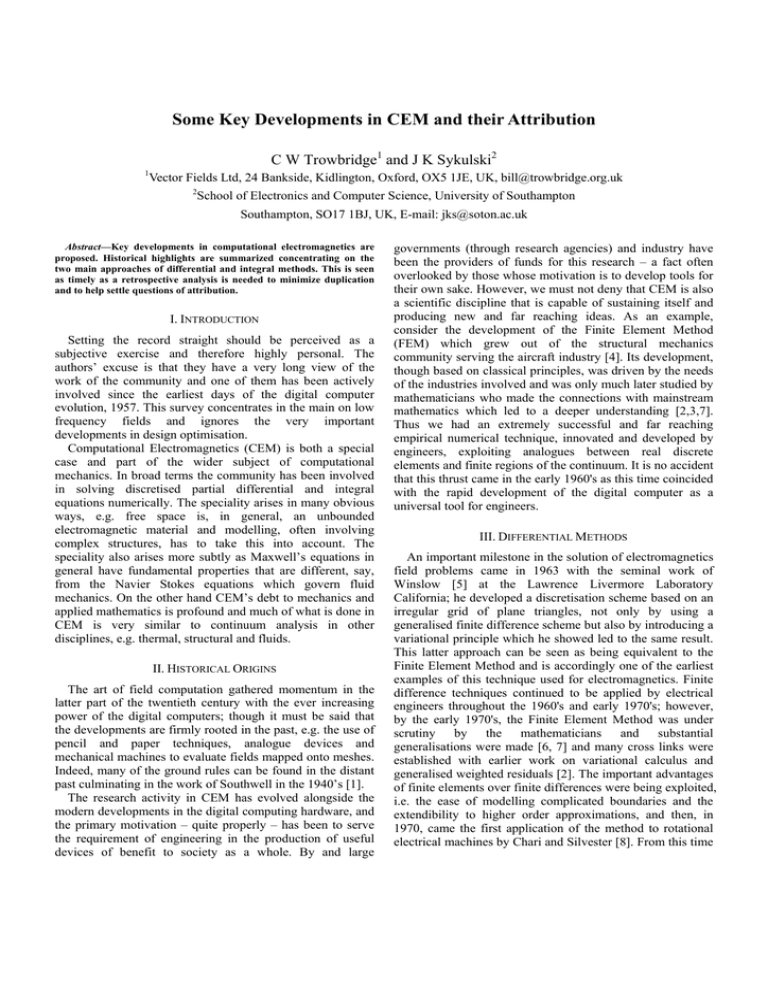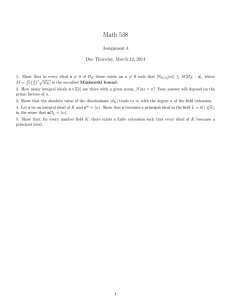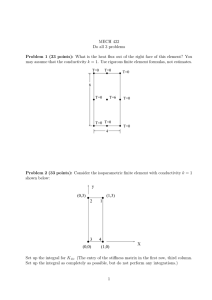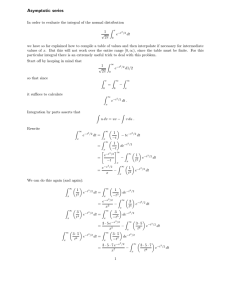- ePrints Soton
advertisement

Some Key Developments in CEM and their Attribution C W Trowbridge1 and J K Sykulski2 1 Vector Fields Ltd, 24 Bankside, Kidlington, Oxford, OX5 1JE, UK, bill@trowbridge.org.uk 2 School of Electronics and Computer Science, University of Southampton Southampton, SO17 1BJ, UK, E-mail: jks@soton.ac.uk Abstract—Key developments in computational electromagnetics are proposed. Historical highlights are summarized concentrating on the two main approaches of differential and integral methods. This is seen as timely as a retrospective analysis is needed to minimize duplication and to help settle questions of attribution. I. INTRODUCTION Setting the record straight should be perceived as a subjective exercise and therefore highly personal. The authors’ excuse is that they have a very long view of the work of the community and one of them has been actively involved since the earliest days of the digital computer evolution, 1957. This survey concentrates in the main on low frequency fields and ignores the very important developments in design optimisation. Computational Electromagnetics (CEM) is both a special case and part of the wider subject of computational mechanics. In broad terms the community has been involved in solving discretised partial differential and integral equations numerically. The speciality arises in many obvious ways, e.g. free space is, in general, an unbounded electromagnetic material and modelling, often involving complex structures, has to take this into account. The speciality also arises more subtly as Maxwell’s equations in general have fundamental properties that are different, say, from the Navier Stokes equations which govern fluid mechanics. On the other hand CEM’s debt to mechanics and applied mathematics is profound and much of what is done in CEM is very similar to continuum analysis in other disciplines, e.g. thermal, structural and fluids. II. HISTORICAL ORIGINS The art of field computation gathered momentum in the latter part of the twentieth century with the ever increasing power of the digital computers; though it must be said that the developments are firmly rooted in the past, e.g. the use of pencil and paper techniques, analogue devices and mechanical machines to evaluate fields mapped onto meshes. Indeed, many of the ground rules can be found in the distant past culminating in the work of Southwell in the 1940’s [1]. The research activity in CEM has evolved alongside the modern developments in the digital computing hardware, and the primary motivation – quite properly – has been to serve the requirement of engineering in the production of useful devices of benefit to society as a whole. By and large governments (through research agencies) and industry have been the providers of funds for this research – a fact often overlooked by those whose motivation is to develop tools for their own sake. However, we must not deny that CEM is also a scientific discipline that is capable of sustaining itself and producing new and far reaching ideas. As an example, consider the development of the Finite Element Method (FEM) which grew out of the structural mechanics community serving the aircraft industry [4]. Its development, though based on classical principles, was driven by the needs of the industries involved and was only much later studied by mathematicians who made the connections with mainstream mathematics which led to a deeper understanding [2,3,7]. Thus we had an extremely successful and far reaching empirical numerical technique, innovated and developed by engineers, exploiting analogues between real discrete elements and finite regions of the continuum. It is no accident that this thrust came in the early 1960's as this time coincided with the rapid development of the digital computer as a universal tool for engineers. III. DIFFERENTIAL METHODS An important milestone in the solution of electromagnetics field problems came in 1963 with the seminal work of Winslow [5] at the Lawrence Livermore Laboratory California; he developed a discretisation scheme based on an irregular grid of plane triangles, not only by using a generalised finite difference scheme but also by introducing a variational principle which he showed led to the same result. This latter approach can be seen as being equivalent to the Finite Element Method and is accordingly one of the earliest examples of this technique used for electromagnetics. Finite difference techniques continued to be applied by electrical engineers throughout the 1960's and early 1970's; however, by the early 1970's, the Finite Element Method was under scrutiny by the mathematicians and substantial generalisations were made [6, 7] and many cross links were established with earlier work on variational calculus and generalised weighted residuals [2]. The important advantages of finite elements over finite differences were being exploited, i.e. the ease of modelling complicated boundaries and the extendibility to higher order approximations, and then, in 1970, came the first application of the method to rotational electrical machines by Chari and Silvester [8]. From this time on the use of the method became widespread leading to generalised applications for time dependent and three dimensional problems [9, 10, 11]. [4] [5] IV INTEGRAL METHODS [6] A parallel development to the above has been with integral methods; these integral formulations, unlike differential formulations which solve the defining partial differential equations (e.g. Poisson's Equation), use the corresponding integral equation forms, e.g. equations based on Gauss' theorem. The moment method is an example of an integral formulation, Harrington [12]; yet another class of integral procedures is the so called boundary element methods [13, 14] based on applications of Greens integral theorems. Whilst these methods are often difficult to apply they can produce accurate economic solutions and have been used extensively in certain static and time dependent problems. [7] V OUTSTANDING ACHEIVEMENTS A subjective list of outstanding achievements over the last thirty years is as follows: a) b) c) d) e) f) g) h) i) j) Pre-conditioned conjugate gradient method known as ICCG (Incomplete Cholesky Conjugate Gradient method) when used for solving large sparse systems of equations [15]. Use of the ‘Delaunay’ method of generating meshes [16, 17]. Kelvin & related transformations for far-field boundary conditions [18, 19]. Finite Difference Time Domain [20] and Finite Volume methods for HF problems [21]. Dual Energy Methods [22]. Transmission Line Matrix Method [23]. Computation of Electromagnetic Forces [24]. The introduction of ‘Edge Elements’, whereby physical conditions are satisfied ab initio with respect to continuity conditions, ‘curl’ and ‘divergence’ using Whitney Forms [25]. Material modelling including new approaches in analyzing hysteretic effects [26, 27]. Fast Multipole methods for integral equations[28, 29]. Further attributions and comments will be given in the final form of the paper. The impact of these developments on design optimisation of practical devices will be addressed. Finally, the needs of the community in terms of teaching and training in CEM techniques will also be considered. REFERENCES [1] [2] [3] R.V. Southwell, Relaxation Methods in Theoretical Physics, OUP, 1946 B. G. Galerkin, “Series Solution of some problems of elastic equilibrium of rods and plates”, Vestn. Inyh. Tech, 19, 987, 1915 S. H. Crandall, Engineering Analysis, New York, McGraw Hill, 1956 [8] [9] [10] [11] [12] [13] [14] [15] [16] [17] [18] [19] [20] [21] [22] [23] [24] [25] [26] [27] [28] [29] M. J. Turner et al, “Stiffness and deflection analysis of complex structures”, J Aero Sci, vol 23, p.805, 1956 A. M. Winslow, “Numerical Calculation of Static Magnetic Fields in an irregular triangle mesh”, University of California Report, UCRL-7784, 1964, J Comput Phys 1, p. 149, 1971. O. C. Zienkiewicz, and R Taylor, The Finite Element Method, McGraw Hill, 1967, 4th ed, 1991 J. T. Oden, “A general theory of finite elements”, Int. J. Num Meth. Eng, 1, 1969 M. V. K. Chari and P. P. Silvester, “Finite Element Analysis of magnetically saturated dc machines”, IEEE Trans. PAS, vol 90, 1971 J. Simkin and C. W. Trowbridge, “Three Dimensional non-linear electromagnetic field computation using scalar potentials”, Proc. IEE, vol 127, no 6, 1980 C. J. Carpenter, “Comparison of alternative formulations of 3-D magnetic field and eddy current problems at power frequencies”, Proc. IEE, vol 124, no 11, 1977 T. Nakata, N. Takahashi et al, “Improvements of the T-Ω method for 3-D eddy current analysis”, IEEE Trans. On Magnetics, vol 24, 1988 R. F. Harrington, Field Computation by Moment Methods, Macmillan, New York, 1968 M. A. Jaswon, “Integral Equation methods in potential theory”, Proc. Roy. Soc. A, p.23, 1963 J. Simkin and C. W. Trowbridge, “Magnetostatic Fields Computed using an Integral Equation derived from Green’s Theorem”, in Compumag Conference on the Computation of Magnetic Fields, 1976 J. A. Meijerink and V. der Vorst, “An Iterative solution method for systems of which the coefficient matrix is a symmetric M matrix”, Maths. Comp., vol 31, 148, 1977 B. Delaunay, “Sur la sphere vide”, Izves. Akad. Nauk. USSR, Math and Nat Sci Div, No 6, p. 793, 1934 Z. Cendes et al, “Magnetic field computation using Delaunay triangulation and complementary finite element methods”, IEEE Trans. On Magnetics, vol 19, 1983 Q. Xiuying and N. Guangzheng, “Electromagnetic field analysis in boundless space by finite element method”, IEEE Trans. On Magnetics, vol 24, 1988 E. M. Freeman and D. A. Lowther, “An open boundary technique for axisymmetric and three dimensional field problems”, IEEE Trans. On Magnetics, vol 25, 1989 K. S. Yee, “Numerical solution of initial boundary value problems involving Maxwell’s equations in isotropic media”, IEEE Trans. On Antennas and Propagation, AP-14, pp. 302-307, 1966 T. Weiland, “Time Domain Electromagnetic Field Computation with Finite Difference Methods”, Int. Journal of Numerical Modelling, 9 (1996), pp. 295-319. P. Hammond and J. K. Sykulski, Engineering Electromagnetism, Oxford Science, OUP, 1994 P. B. Johns, “Application of the transmission-line matrix method to homogeneous waveguides of arbitrary cross section”, Proc. Inst. Electr. Eng., vol 119, pp 209-215, Mar 1974 J. L. Coulomb and G. Meunier, “Finite Element Implementation of virtual work principle for magnetic force and torque computation”, IEEE Trans Mag, vol 20, 1985 A. Bossavit, “Whitney forms: a class of finite elements for three-dimensional computations in electromagnetism”, IEE Proc. A, vol 135, pp. 493-500, 1988. I. M. Mayergoyz, “Mathematical models of hysteresis”, IEEE Trans Mag, vol 22, 1986 A. Reimers, E. Della Torre et al, “Implementation of the Preisach DOK Magnetic Hysteresis Model in a FE Package”, IEEE Trans Mag, vol 37, 5, pp. 3362, 2001 L. Greengard, V. Rokhlin, “A new version of the Fast Multipole Method for the Laplace Equation in three dimensions”, Acta Numerica, pp. 229-269, 1997 A. Buchau, W. Rieger, W. Rucker, “BEM Computations using the Fast Multipole Method in Combination with Higher Order Elements and the Galerkin Method”, IEEE Trans Mag, to appear 2001, email: andre.buchau@ite.uni-stuttgart.de


